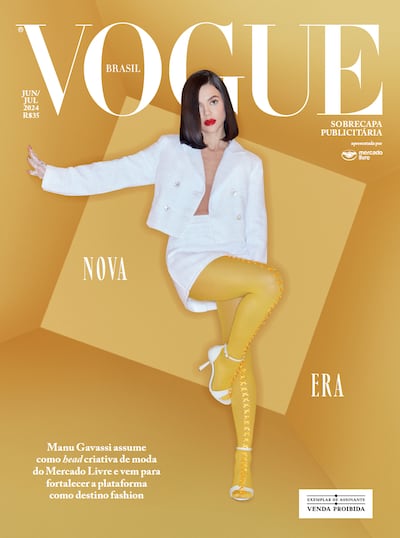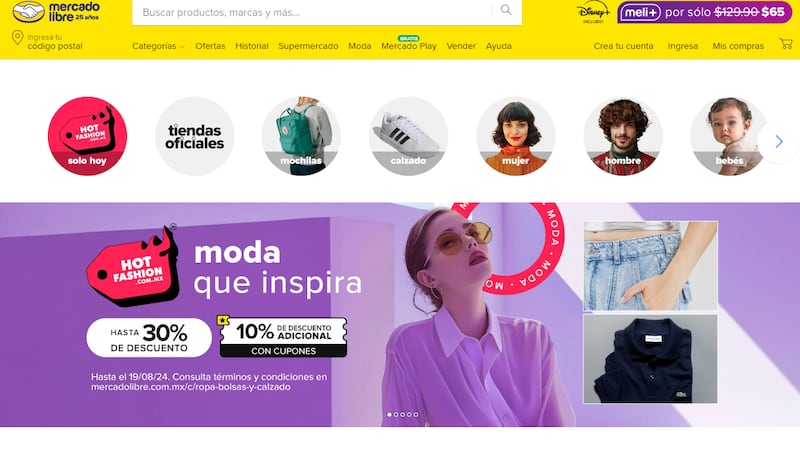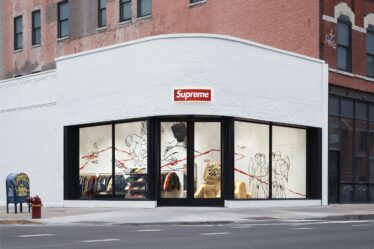
Competition in the Latin American e-commerce market is heating up, with both local players and Asian heavyweights making inroads in a region dominated by one firm. Yet the task of dethroning “Latin America’s answer to Amazon,” as Mercado Libre is often called, remains daunting.
Last year, 218 million of the region’s 670 million people used Mercado Libre across 18 countries, including consumers in key fashion markets like Brazil, Mexico, Colombia, Chile, Argentina and Peru. Buying and selling everything from electronics and cars to real estate and clothing, users of the sprawling marketplace can also take advantage of the e-tailer’s suite of payment services.
The scale of the Mercado Libre business is vast. In February, the firm posted full year net income of $1.2 billion against revenue of around $14.5 billion. Six months later, it became the largest listed company in Latin America when a rally brought its market capitalisation to $90 billion. With its nearest regional e-commerce competitors lagging far behind, the company is now in a league of its own. In the fashion segment, however, Mercado Libre’s credibility has been lacking.
“I don’t think consumers are adopting it as a style destination. It’s trying to inspire but it’s not yet a place that sparks a desire for fashion,” says Buenos Aires-based fashion industry veteran and consultant Gaba Najmanovich. “People go there because it’s affordable and convenient.”
The pandemic did spur more fashion brands to join Mercado Libre. Today the e-tailer offers a range of products from Calvin Klein and Tommy Hilfiger to labels “commanding a slightly higher price point” like Hugo Boss and Pandora, says Luis Pedraza, the company’s commercial director in Mexico. Yet it has been hard for Mercado Libre to shake its reputation as a platform for basics and a retailer whose brand mix fails to inspire trendsetters.
Company leaders are unlikely to be deterred by such challenges. Founder and chief executive Marcos Galperin did not become Argentina’s wealthiest man — Forbes estimates his net worth to be in excess of $7 billion — by taking Mercado Libre’s success for granted.
Recognising that the company needed a makeover to take full advantage of the region’s $132 billion fashion market, he recently set in motion a plan to get one. Last month, 25 years after he co-founded the firm, Galperin enlisted two well-known influencers as fashion ambassadors for the e-tailer’s largest country markets.
Investing big in Brazil and Mexico
The platform’s Brazil unit, Mercado Livre (its Portuguese translation), hired Manu Gavassi, a 31-year-old singer, actress and fashion influencer with a loyal following of 27 million across her social channels, including nearly 15 million on Instagram. Having appeared on the covers of local editions of Vogue, Elle and Grazia, she has secured numerous fashion and beauty endorsement deals over the years, including mass market brands that are already available on the platform such as Mac, L’Oréal, Fila, Paco Rabanne and local labels Colcci and Havaianas.
“We know her potential as a fashion ambassador, helping to position Mercado Livre as a category leader and a main fashion destination [by] creating a strong connection…[with] consumers,” explains Julia Rueff, the São Paulo-based vice president of marketplace for Mercado Livre at the time of Gavassi’s hire.
The e-tailer’s ambitions for Gavassi extend beyond the conventional influencer playbook. Elevating her to a role called ‘creative head of fashion’, it has made her an ostensive business partner with decision-making power. “We wanted someone who could bring unique curations to our business and have 360-degree participation in our marketing strategies to build a solid narrative for the fashion category throughout the year,” Rueff explains.
To that end, Mercado Livre sponsored a Vogue Brazil cover featuring Gavassi in June. It is too early to tell whether the move has been effective in boosting the e-tailer’s fashion credibility among the magazine’s more affluent, design-led consumer readers — or indeed whether it was intended to boost Gavassi’s own credibility in the context of Brazil’s constellation of more established high-fashion influencers who double as industry insiders.
Unsurprisingly perhaps, Vogue Brazil’s editor-in-chief Paula Merlo has praised Gavassi for her understanding of trends and broad appeal. “She’s an approachable fashionista,” she says, highlighting her relatable personality and style that resonates with consumer groups spanning from “Gen-Z to middle-class older Millennials.”
But much like the debate surrounding Amazon’s intermittent efforts to position itself as a fashion player in the US market, Mercado Libre’s strategy raises questions about the right approach for a mass-market e-tailer looking to gain market share from the likes of global fast fashion and local high-street players.
Najmanovich remains sceptical. She doesn’t see it “taking off,” she says, unless the e-tailer’s aesthetics and user experience change in step with its recent marketing investments.
Claudia Candano, editor-in-chief of Elle Mexico, believes Mercado Libre has the potential to achieve its objectives but offers a caveat. “Mercado Libre can indeed be seen as a fashion destination, provided it aligns its communication and offerings with the preferences of [younger] consumers they’re targeting,” she says.
That may be what the Mexican unit of Mercado Libre was hoping to achieve when it hired its own celebrity ambassador last month. Timed for the launch of a fashion-focused Instagram account, the e-tailer partnered with Sofía Reyes, a 28-year-old singer linked to brands like Lacoste, Skechers, Tous, Dior Beauty and Fendi who has 2.5 million Instagram followers, 1.7 million TikTok followers and covers of the local editions of Vogue and Elle under her belt.
Some fashion insiders have been less than enthusiastic about the appointment. Olivia Meza, founder of Mexican fashion magazine Meow Mag, suggests that Reyes is not an ideal choice as fashion creative director. “I wouldn’t see a singer in that role— not due to a lack of fashion insight, but because a specialised individual or team could offer something unique beyond the typical influencer strategy,” she says.
Mercado Libre executives, on the other hand, seem confident that Reyes will have an impact. Pedraza, for example, has described Reyes as a “true spokesperson for contemporary fashion.”
Rachel La Rocca, the e-tailer’s Chile-based senior fashion director, highlights what’s riding on the appointment. “Fashion is expected to be one of the fastest-growing categories in 2024 [across the entire Latin American region] which makes it a priority segment for the company,” she says.
The company’s regional fashion sales grew by a staggering 27 percent in 2023 compared to the previous year, she notes, with Brazil accounting for over half of overall sales, followed by Mexico in second place.
The company is clearly buoyed by the fashion category’s double-digit growth rates but that is not the only motivation for its influencer hires. Experts suggest that Mercado Libre’s sizeable marketing investments are meant to counter a very specific new threat.
Stiff competition from Asian heavyweights
“Mercado Libre already made its way into fashion [before this year’s influencer deals],” explains Fatima Linares, insight manager at Euromonitor International, citing a study from the market research firm, noting that the company accounted for 17 percent of the region’s apparel and footwear e-commerce sales in 2023, a share that has nearly tripled since pre-pandemic levels to surpass $3 billion. But she hastens to point out that “competition is getting harder,” referring specifically to the entry of Shein into Latin America.
In just three years, the China-founded, Singapore-based ultra-fast fashion e-tailer has secured a 12 percent share of e-commerce sales in the fashion segment, surpassing $2 billion. “It is yet to be seen if Shein’s low-cost will be enough to beat Mercado Libre in this industry,” Linares says.

The Euromonitor study found that Spain’s Privalia, in a distant third spot, achieved sales of around $600 million in the region. Other notable competitors include Brazil’s Dafiti, Netshoes (acquired by Magazine Luiza also known as ‘Magalu’ in 2020), Lojas Renner, Singapore’s Shopee, and Mexican department stores Liverpool and Coppel. China-founded Temu has also entered the region.
The rapid advancement of Asian players into the region saw Mercado Libre’s Brazilian rival Magazine Luiza respond by partnering with Chinese behemoth AliExpress, while Brazilian fashion giants Arezzo & Co. and Grupo Soma merged to create Azzas 2154, a $2.5 billion conglomerate to strengthen their market position.
Given the scale of the online opportunity, it’s no surprise Mercado Libre faces stiff competition. According to Euromonitor, Latin America’s e-commerce market was valued at $132.8 billion in 2023, up 17 percent from the previous year.
“While not as vast as Amazon in the US or Europe, Mercado Libre commands 28 percent share of the [overall Latin American] e-commerce market,” says Matteo Ceurvels, principal analyst for eMarketer in Latin America. He highlights the e-tailer’s reported $44.79 billion gross merchandise volume in 2023, exceeding 30 percent growth on the previous year.
To put this into perspective, the combined market share of Mercado Libre’s closest competitors — Magazine Luiza, Amazon Mexico, Grupo Casas Bahia, Falabella and Walmart Mexico and Central America — amounts to 22 percent, according to eMarketer.
Asian companies Shopee, Shein and Temu have thrived in Latin America thanks in part to their mobile-first approach. Meanwhile, apps from department stores Liverpool and Coppel in Mexico and Falabella in Peru, Chile, and Colombia have also gained in popularity.
La Rocca is quick to defend Mercado Libre’s credentials in m-commerce. “Our fashion and beauty initiatives are designed from a mobile-first perspective,” she said. Across all categories, mobile commerce drove 81.8 percent of sales, according to the firm’s sustainability report.
While Candano says that Mercado Libre’s overarching fashion strategy “seems correct” in principle, she believes “it needs to be more aligned with what Gen-Z is looking for in terms of shopping, look and feel,” referring to the approach of its new fashion account on Instagram which she feels is more attuned to Millennials. “When compared, Shein seems to have a better grasp of what Gen-Z is looking for,” she notes.
Nonetheless, “Mercado Libre is making a strong effort in general positioning, which could uplift their fashion segment,” concedes Candano, adding that it has the potential to curate a compelling selection for users but stresses that its marketing must be “stronger, clearer and more impactful.”
Mercado Livre executives like Rueff believe that Gavassi’s involvement could go some way toward addressing such concerns in the Brazilian market as she believes the influencer’s “authenticity and curation will emotionally connect with consumers,” especially Gen Z.
Emotional impact aside, one strength the platform has is extensive reach, a fact that fashion brands sold on the site are ready to attest to. “Mercado Libre…has helped us attract new customers previously unaware of the brand,” says Paula Sturm, e-commerce chief for Buenos Aires-based Big Bloom, parent company of brands Wanama and John L. Cook, praising the platform’s “trust-building” strategies and payment options.
Another strength of ubiquitous platforms like Mercado Libre is that repeat-purchase items in categories like beauty (particularly skincare and perfume) and staples like underwear, activewear and sportswear can become a gateway for customers to discover new fashion brands on the platform.
The company cites Adidas, Nike and Puma as highly ranking brands in regional searches. Popular beauty brands on the platform include Maybelline, Nyx, Nuxe, Clinique, Charlotte Tilbury, Mac, The Ordinary and Estée Lauder.
Sturm cautions that “Mercado Libre shoppers are loyal [but] expect fast delivery.” And although she commends the company’s “high standards” in customer service and delivery, she warns that sellers “require a 97 percent on-time dispatch rate to stay visible in searches,” adding that the platform’s fees can be a downside.
Yet one pillar of Mercado Libre’s recent fashion strategy has been to help onboard smaller fashion businesses and manufacturers across Latin America by equipping them with finance tools and digital training. According to La Rocca, nearly 3.5 million sellers in the region sold clothing, footwear and accessories on the platform last year.
Company founder Galperin regularly seizes on this in public forums, claiming that Mercado Libre was the catalyst that “democratised” commerce and finance in the region. To what degree the tycoon was motivated by social impact is up for debate but what is incontestable is his own social background.
Pioneering e-commerce in Latin America
Born in Buenos Aires into a wealthy Argentine family, co-founder Marcos Galperin was surrounded by examples of entrepreneurship as a child. His grandfather, Walter Lebach, founded Sadesa, a major tannery that has supplied leather and other products to brands including Nike and Adidas. Though he could have continued the family business or pursued a sports career with Argentina’s national rugby team, he chose to build his own tech empire.
Galperin launched Mercado Libre in 1999 from a garage in his hometown, while still studying at Stanford University in the US. His vision for the platform, which means “free market” in Spanish, was supported by fellow graduates Hernan Kazah and Stelleo Tolda. Inspired by eBay in the US, the co-founders initially started in just four countries in Latin America but by 2007 they had gone public, listing the company on the Nasdaq exchange.

Despite facing far more challenges than expected in the early years of his entrepreneurial journey, Galperin pursued a long-term plan that helped him outdo his rivals and prove most of his detractors wrong — so far, at least.
A decade after unlocking the online retail market by launching Mercado Pago, a payments platform similar to PayPal, he opened the logistics service Mercado Envios. These innovations changed the e-commerce game in Latin America, addressing longtime hurdles such as the lack of secure online payment options, low rates of banking penetration, and unreliable postal services.
The company has since expanded into financing, for both buyers and sellers, with Mercado Crédito and into a Shopify-like ‘all-in-one’ retail service called Mercado Shops, which competes with both Shopify and TiendaNube. Meanwhile, its advertising platform has ballooned in recent years and is now estimated to command over half of the retail media ad spend in Latin America, exceeding $1 billion, according to eMarketer. To top it off, last year, the firm ventured into streaming services.
The e-tailer’s complementary suite of services has created an “ecosystem that is highly attractive for buyers and sellers,” says Pedraza, highlighting Mercado Libre’s ability to deliver to many cities in the vast Mexico market within 24 to 48 hours.
“We are proud of our 25-year achievements, but our mission is far from complete,” says company chief financial officer Martín de los Santos, noting that e-commerce in the region is “far from mature” and financial services are “ripe for disruption.”
If the picture painted by his boss Galperin in recent media interviews is anything to go by then the company is bracing itself for these next “big bumps in the road.”
The steely CEO may have attracted the attention of antitrust regulators over the dominant position he carved out for the e-commerce giant he created, but he has also earned bragging rights over the company’s reputation as a sector-leader in every major country across a region that is plagued by both political and economic instability.
To help him mitigate some of this volatility, Galperin leads Mercado Libre from the relative calm of Montevideo, Uruguay. However, this means he must do so remotely, managing a sprawling company that maintains its de facto headquarters across the border in Buenos Aires, Argentina, a country economists describe as being in ‘perpetual crisis.’
These are accomplishments that even those who doubt his latest plan — to transform ‘the Amazon of Latin America’ into a leading fashion destination — can only be impressed by.



